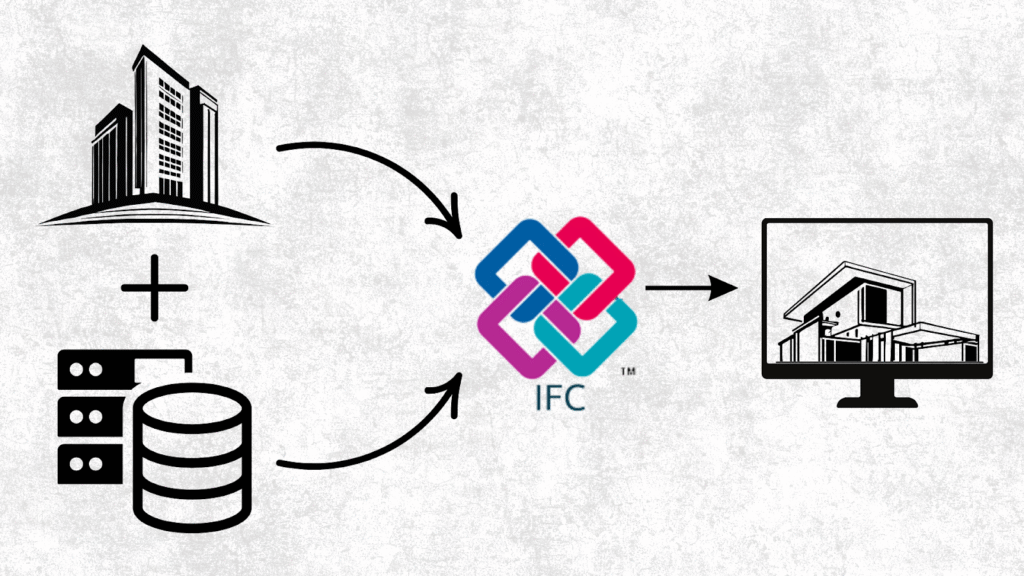In today’s construction industry, where multiple teams, tools, and timelines must align, smooth collaboration is more than a necessity. Yet, many professionals still face delays, rework, and data loss due to disconnected systems. This is where Open BIM offers a smarter, more connected approach. It enables seamless data sharing across different software platforms through open standards, improving coordination and reducing errors.
In this blog, we’ll explore what Open BIM is, why it matters, and how it improves project delivery. You’ll learn about the importance of Open BIM, the role of Industry Foundation Classes (IFC) in data sharing, and key benefits for collaboration. We’ll also highlight the limitations of OpenBIM and its future in digital construction.
What is Open BIM?
Open BIM is a modern approach to building design and construction that focuses on open standards and smooth collaboration between different software platforms. Instead of being locked into one tool or vendor, Open BIM lets architects, engineers, contractors, and other stakeholders share information freely using formats like IFC (Industry Foundation Classes). This means you can work with teams using different tools without losing data or having to redo work.
To understand how Open BIM became a key part of today’s construction workflows, you need to look at its origins and development over time.
History of Open BIM
Open BIM started gaining attention in the early 2000s as the construction industry recognized the need for better communication and data exchange between various tools and teams.
Before Open BIM, many software programs used proprietary formats, which made sharing information difficult and led to inefficiencies. Open BIM introduced open standards like Industry Foundation Classes (IFC), which allow different software systems to exchange data seamlessly, regardless of the vendor.
Organizations like buildingSMART International have played a key role in developing and promoting Open BIM standards worldwide. Over time, Open BIM has helped improve project coordination, reduce errors, and increase transparency among architects, engineers, contractors, and owners.
Today, Open BIM continues to evolve, encouraging innovation and cooperation in the building industry by enabling more integrated and efficient workflows across diverse software environments.
To better understand the value of Open BIM, it’s important to see how it compares with Closed BIM.
Difference Between Open BIM and Closed BIM
In the world of Building Information Modeling (BIM), two main approaches are commonly used: Open BIM and Closed BIM. These approaches differ primarily in how data is shared and which software systems are involved. Understanding these differences helps project teams choose the right method for collaboration, efficiency, and flexibility.
| Features | Open BIM | Closed BIM |
| Data Standards | Uses open, neutral standards like IFC for data exchange | Uses proprietary formats specific to one software |
| Software Compatibility | Supports multiple software platforms and vendors | Limited to a single vendor’s software ecosystem |
| Collaboration | Encourages open collaboration across different teams and tools | Collaboration is confined within one software system |
| Flexibility | High flexibility to integrate diverse tools and workflows | Less flexible; dependent on specific software capabilities |
| Cost | Potentially lower costs due to the use of open standards and diverse tools | May involve higher costs due to licensing and vendor lock-in |
| Data Control | Data ownership is shared and more transparent | Data is controlled within one vendor’s system |
| Project Scope | Ideal for large, multidisciplinary projects requiring multiple software tools | Suitable for smaller projects or teams using one software |
Open BIM is more than just a way to share data; it changes how your project team connects and communicates. Seeing why it matters will help you appreciate the real benefits it brings to everyday construction work.
Importance of Using Open BIM

Open BIM is becoming an essential part of digital construction, offering a smarter, more flexible way to manage building projects from start to finish. Encouraging open collaboration, improving data flow, and supporting long-term digital growth, Open BIM helps teams work more efficiently and make better decisions.
The following are some of the most important benefits that highlight why using Open BIM can add real value to your projects:
- Smooth Collaboration Between Teams
Open BIM makes it easier for everyone involved in a project, whether it’s architects, engineers, contractors, or building owners, to work together without worrying about which software they use. With open standards like IFC, information flows freely between teams, removing communication barriers and helping everyone stay connected and on the same page throughout the project.
- Freedom from Vendor Lock-In
With Open BIM, you aren’t tied to a single software provider. This vendor-neutral setup lets you pick the right tools for each task, adapt quickly to new technology, and avoid expensive software restrictions. It gives you the flexibility to work with any partners or consultants, supporting innovation and digital growth in your projects.
- Better Data Quality and Easy Access
Open BIM helps keep your project data consistent and available from start to finish. Using open formats reduces duplicated work and cuts down on mistakes. Everyone involved can access and update the same data, which maintains accuracy and trustworthiness from design through to building operation.
- Preparing for the Future
Because Open BIM is based on open standards, your project data stays compatible with future software and technology. This protects your investment, ensures long-term access to important information, and makes adding new tools or workflows easier as the industry changes.
- Saving Time and Costs
By enabling seamless software integration and cutting out repeated data entry, Open BIM makes your workflows faster and less prone to errors. This helps you complete projects more efficiently, saving both time and money while improving overall results.
- Compliance with International Standards – ISO 19650.
Open BIM helps meet global standards like ISO 19650, which provides guidelines for managing information throughout a building’s lifecycle using BIM. Following these standards ensures that data is handled in a clear and consistent way, improving coordination and reducing risks.
As Open BIM utilizes standard formats like IFC, it facilitates teams in adhering to ISO 19650 and maintaining high levels of quality, transparency, and accountability in their projects.
Also read: IFC in Digital Construction: Uses, Importing, Exporting, and Compliance
With the benefits of Open BIM, the next step is to understand the tools that make this collaboration possible. One of the most important tools here is IFC, which acts as the backbone for sharing data across different platforms and teams.
Role of IFC in Open BIM Workflow

IFC (Industry Foundation Classes) plays a vital role in the Open BIM workflow by enabling smooth data exchange, promoting collaboration, and ensuring software compatibility across the construction process.
The points below highlight some of the key roles IFC plays in making Open BIM truly effective:
- Common Format for Data Sharing
IFC works like a shared language that allows different software systems to exchange and understand project data without losing important details. This means you can create a design in one tool and pass it to another without starting over, keeping everyone connected and informed.
- Works Across Different Software
One of the biggest strengths of IFC is its ability to connect various BIM tools. Whether you’re using Revit, ArchiCAD, or something else, IFC makes sure the information can be used across all platforms, helping teams collaborate without software limits.
- Keeps Data Accurate and Consistent
IFC helps standardise how building elements are described, which keeps your data clear and consistent from start to finish. This reduces the chances of mistakes or missing information and leads to better project results.
- Supports the Full Building Lifecycle
IFC’s open format means your data stays useful from the early design phase to construction and even into building operation. This makes long-term maintenance easier and helps your project stay adaptable over time.
- Safe and Flexible Information Sharing
Since IFC is an open, non-proprietary format, you’re not stuck using one company’s software. It gives you a safe, reliable way to share information with both your internal team and outside partners, without worrying about compatibility issues.
Ready to simplify your projects and achieve the benefits?
BIM ASSOCIATES is your one-stop BIM Solution provider for Revit Architectural and Structural Solutions. They coordinate with your team to develop, record, and streamline the BIM Revit Model, along with the sheets, Bill of Quantities, Bill of Materials, and clash coordination.
IFC’s role in Open BIM is essential, but it also brings some practical challenges that can impact project delivery. Exploring these limitations helps you stay ahead of potential issues and make the most of the technology.
Limitations of Using IFC in Open BIM
In Open BIM workflows, IFC (Industry Foundation Classes) is the main format used to share building data between different software tools. While it offers many advantages, working with IFC also comes with certain challenges.
Here are some common limitations you might face and practical ways to manage them effectively:
| Challenges | Solutions |
| Data Loss or Errors During File Exchange | Use software supporting the latest IFC versions.Perform regular quality checks.Define clear data requirements early. |
| Missing Support for Advanced Software Features | Agree on essential features before starting.Use commonly supported elements.Avoid software-specific features that can’t be transferred. |
| IFC Schema Can Be Difficult to Understand | Provide simple IFC training for the team.Use easy-to-follow templates.Get help from BIM experts when needed. |
| Different Software Interpret IFC Differently | Choose certified IFC-compatible software.Regularly update software.Test file exchanges before project start.Document known issues. |
| Large File Sizes and Slower Performance | Break large models into smaller parts.Use IFC referencing.Clean unnecessary data before exporting. |
| Difficulty Managing File Versions and Updates | Use a common data environment (CDE) or cloud platform.Set clear protocols for file naming, sharing, and approvals. |
Acknowledging the hurdles with IFC helps you prepare better, but it’s also important to focus on what lies ahead. The future of Open BIM and IFC holds opportunities to overcome these challenges and transform the way projects are managed.
Future of Open BIM and IFC
Open BIM and IFC are becoming essential for improving collaboration and data sharing in construction projects. IFC ensures smooth communication between different software without locking you into one vendor.
With the rise of new technologies and open standards, workflows are becoming more flexible and efficient. The following are some key trends shaping the future of Open BIM and IFC:
- Continued Importance of IFC Standards
IFC, or Industry Foundation Classes, will remain the core standard that keeps Open BIM working smoothly. It acts as a universal language so that different BIM software tools can easily share and understand project information. This means your data won’t be stuck inside one company’s software, giving you more freedom and flexibility throughout the project’s life.
- Greater Interoperability with Open Standards
There is a strong focus on making sure all software and teams can work together better. Open standards like IFC and the buildingSMART Data Dictionary (bSDD) help make project data consistent and richer. These standards allow different disciplines—such as architects, engineers, and contractors—to exchange information easily and avoid misunderstandings, improving coordination and saving time.
- Integration of Artificial Intelligence
Artificial intelligence (AI) is set to play a bigger role in Open BIM. AI can help automate routine tasks like design checks, spotting errors or clashes faster than humans can. It also supports smarter decision-making by analysing large amounts of data quickly. This will make projects more accurate, reduce mistakes, and speed up the design process.
- Use of Digital Twins for Better Facility Management
Digital twins combine BIM models with live data from sensors installed in a building. This means you can monitor how a building performs in real time, manage maintenance more efficiently, and even predict problems before they happen. This approach saves money and helps keep buildings running smoothly long after construction is complete.
- Cloud-Based Collaboration and Enhanced Sustainability
Cloud technology allows project teams to work together in real time from any location. This boosts communication and reduces errors caused by outdated information. At the same time, Open BIM will help track sustainability factors such as carbon emissions and lifecycle impacts. This supports important environmental goals like reducing waste and achieving net-zero carbon footprints.
- Emerging New Data Formats
While IFC remains important, new data formats like Universal Scene Description (USD) are being developed. These newer formats promise to offer even better ways to exchange and visualize data, allowing for more detailed and interactive models. This means in the near future, you can expect richer digital representations of buildings that improve understanding and decision-making.
BIM Supports GREEN EARTH.
Conclusion
A thorough understanding of Open BIM and its significance is vital for enhancing collaboration and efficiency in modern construction projects. Using IFC helps ensure smooth, reliable data exchange across different platforms.
Still, limitations of OpenBIM, like software compatibility issues and possible data inconsistencies, need careful handling. By addressing these early, you can unlock its full potential and achieve better project results.
Are you looking for BIM solutions?
BIM ASSOCIATES is your one-stop BIM Solution provider for the Architecture and Structure discipline. Their solutions help clients with better decision-making, cost-saving, efficient construction planning, and green earth initiatives.
You might also like: Steps for BIM Implementation: 7 Strategies for Success.
FAQs (Frequently Asked Questions)
- How does Open BIM differ from Closed BIM?
Open BIM uses open, non-proprietary formats like IFC to share data, which means any software that supports these formats can join the workflow. On the other hand, Closed BIM depends on proprietary file formats, so everyone has to use the same software. This limits flexibility and makes collaboration harder.
- What is IFC, and why is it important in Open BIM?
IFC, or Industry Foundation Classes, is an open data format used in Open BIM. It allows different software programs to exchange building information without losing any data or quality. This makes working together on projects much smoother and more reliable.
- What are the main limitations of Open BIM?
Open BIM faces some challenges. Converting models to open formats like IFC can cause loss or misinterpretation of details, especially with complex designs or special software features. Not all software fully supports every IFC aspect, leading to data inconsistencies. Teams may also need training to use open standards effectively. Also, some advanced proprietary features aren’t fully supported in open formats, limiting certain capabilities.
- Can Open BIM improve project efficiency?
Yes, Open BIM makes sharing information easier and reduces mistakes caused by incompatible file formats. This improves coordination, cuts down on misunderstandings, and helps projects finish faster and smoother.
- Does Open BIM support long-term use of project data?
Absolutely. Open BIM keeps your project data accessible and usable throughout the building’s entire lifecycle, even if the original software becomes outdated. This is very helpful for future renovations, maintenance, and managing the building over time.
- Is Open BIM suitable for projects of all sizes?
Yes, Open BIM works well for both small and large projects. Its open standards make it easier for teams of any size to work together without being tied to a specific software.
- What should you keep in mind before adopting Open BIM?
First, check whether your current software supports open standards like IFC. Plan for training so your team can learn how to use Open BIM effectively. Be prepared for possible data translation issues and test your workflows early in the project. Lastly, make sure all stakeholders are on board with using open processes to get the best results.

